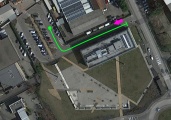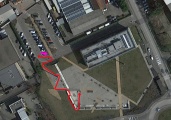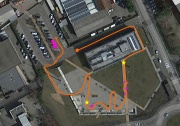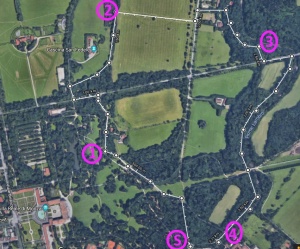Race Models
Indice
Preface
Street Mini 4WD competitions are based on different types of paths that pilots and their cars have to face.
The path depends on the type of race:
- Fast tracks: the most important thing is the top speed and the ability of the driver and the car to handle it. (Top Speed role);
- Technical routes (narrow curves and jumps): it requires the combination of guidance and stability of the car, combined with agility and quick thinking of the pilot (Tech role);
- Paths with wide curves: the key skills are cornering grip, the maximum speed at which you can handle the curves and the pilot's ability to make curves properly. (Mixed role);
- Variable routes: the racer and his car must be able to face difficulties that involve complex, sometimes unexpected situations (Variable role);
Three major types of competition are possible: individual competitions (the Challenge), team competitions (the Cup format and the Tuning format) and couple competitions on extreme paths (the Rally).
The Challenge (Individual competitions)
This is one vs one competition: the racer competes on four races characterized by different types of tracks (speed , technical, mixed, variable).
- The fast track is characterized by straights and very wide curves to travel at maximum speed. On this track is important the top speed;
- The mixed track is characterized by high-speed corners with a minimum radius of 120cm and no more than 160cm. On this track counts the speed in the corners and especially the cornering stability.
- The technical track generally begins with a start followed immediately by a curve, and continues with a succession of curves with a maximum radius of between 90cm and 110cm. On this track is important the recovery and the agility of the racer to the sudden change of direction;
- The variable track provides for sometimes unexpected difficulties, for example changes in the ground, jumps, difficult surfaces, for which the adaptability / versatility of the car and the racer to the variations of the surface and the course is important;
Racers will challenge each type of specialty. In the end, the best will be awarded for each track.
- (OPTIONAL) : The four best racers compete in a combined race to decree the champion of the event. In a combined race, the efficiency of the car and the clarity of the racer are important. This methodology could decree the so-called Leader among the three winners;
- (OPTIONAL) : The four best racers of the event become the captains of a team composed by selecting complementary members to their captain. The complementarity of a racer to his captain is indeed given by the results obtained in the 4 individual races. After having composed the teams, they race on a path containing all three types of tracing ( 'sectional path' ).
Typically, each track has an average length from 90 meters to 150 meters.
Composition of a Street Mini 4WD team
The individual competitions described allows to identify racers prevalent skills and makes it possible to create a Street Mini 4WD team composed by racers with different skills.
The Cup (Team competitions)
These races consist into the competition between two or more teams of 2-5 elements. Key elements are team play and complementarity between team riders.
We can identify 4 main types of team races:
- Sectional race (relay race): A track consisting of segments with different characteristics is divided into sections and each member runs one according to its own peculiarities. For example: for teams of five elements you draw a track divided into 5 parts, each one with different characteristics;
- Endurance race: A single track is run in turn by each pilot, like a relay. For example the circuit must be run five times, each racer of the team completes a track ride;
- Target race: No defined route is provided. Pilots must reach the target points where the next staff member will be waiting for them;
- GP Cross: a path is simultaneously traversed by two or more racers for a team at the same time. Wins the team that first manages to complete the course with its last car. In practice, wins the first car among the last.
Every single track is long in its develop approximately from 90 meters to 300 meters.
Usually a team event ends with one or more final races. If the final race is unique, a sectional track is usually preferred. In the case of races with multiple final stages (for example, located in several places), it is decided to collect the differences in the arrival times of the drivers in the race: each team will start the next stage based on these time differences.
Tuning Races (Team events with only one car)
This race format provides for a team consisting of a minimum of 3 racers and a maximum of 5.
It is a matter of covering the entire event in relay races in which the 3 racers drive a single common car.
The Tuning Races races have ONE owner car and ONE spare car (forklift) per team.
The difficulties to be faced for the team are mainly given by the management of this ONE MACHINE.
Managing the reserve car (forklift) is another challenge: if the owner car is damaged before reaching the final, the team can decide to replace it with the forklift car. The substitution can only be made BEFORE the start of the semifinals.
Team car rules: must have logo and colors that reflect the team uniform.
The Rally (races in pairs on extreme path)
These kinds of races are carried out as if they were a real rally.
You have tracks with rather long stages (minimum 3Km) on extremely variable ground, with dirt, grass, puddles, etc... in which the normal mini 4WD may have difficulty to go on. In Rally races, teams are composed of two elements: a pilot and a navigator.
The pilot of the couple in the race controls with the guide stick only one mini 4WD while the navigator takes care of the road ahead, check the ground that will be faced and suggest any shortcuts. The main features of this kind of competitions are:
- Pilot and navigator can exchange themselves in driving their mini 4WD;
- It is possible to have a spare car in its fleet of 2 cars;
- Each pair can have only a mini 4WD of the Wild category in its fleet: this means that it will be at the discretion of the couple to decide whether to use 2 normal 4WD mini or 4WD mini and a Wild mini 4WD during this kind of competition;
- First car and a spare car can be exchanged at the discretion of the racers, as long as they are not driven at the same time.
The competition is won by the couple's car that arrives for the first one at the finish line represented by the last target of the track.
Sommario
| Storia |
| Generale |
| Tecnica
Guida · Pneumatici · Pile · Motori · Meccanica · Assetto · Telai · Fisica · Sospensioni · Materiali plastici · Stampa 3D |
| Tutorial |
| Gare |
| Contatti |









